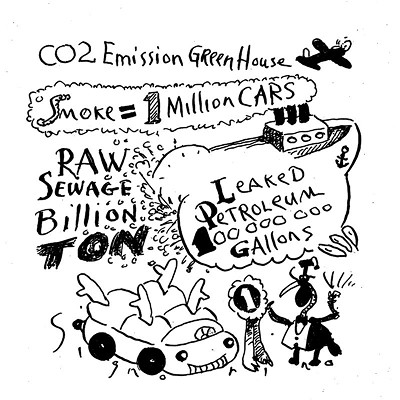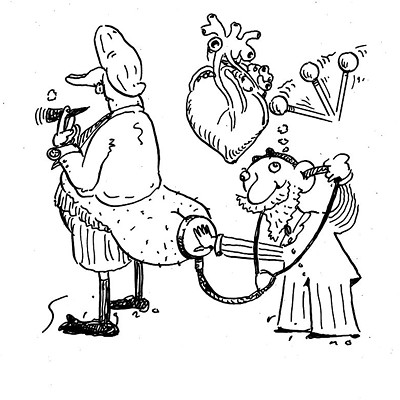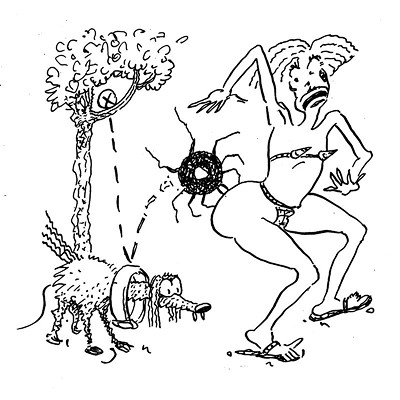Would life have evolved differently on earth if we'd never had a moon? Would dark nights have resulted in our ancestors getting pwned in their caves, or would they have evolved X-ray vision?
—Naman Dixit
FIRST OF ALL, get your superpowers straight: while X-ray vision is undoubtedly a useful feature, it wouldn’t do much to prevent midnight toe-stubbings amongst the Cro-Magnons.
Infrared vision, sure—but if you’re hung up on how we could have evolved into some cooler, laser-eyed superspecies without that crappy moon holding us back, you’re not counting your evolutionary blessings.
By most accounts we wouldn’t even have developed vertebrae without the moon, let alone eyeballs. Dark nights would be the least of our problems.
Cosmologically speaking, earth has been extremely lucky. Our sun’s energy output has remained relatively stable throughout much of the evolution of life. Our orbit is safely in what’s called the habitable zone, where a planet’s surface can support liquid water. We’ve avoided being smashed to smithereens by comets, sucked into black holes, or irradiated by supernovae. With all the hazards of the universe in the way, the chances of life developing on any planet are pretty small.
It’s fairly well established that the life-sustaining conditions found on earth have been enhanced to some degree by its lunar companion; the only debate is about how much. Some of the more commonly proposed benefits of moon-having:
It got rid of primordial pollution. The moon most likely formed when some smaller planet struck earth about 4.5 billion years ago, ejecting chunks of debris that eventually coalesced in orbit. Crucially, this collision may also have stripped away a thick proto-atmosphere that was trapping the heat of earth’s molten surface. Without this rather violent development we might have ended up like Venus, where life is only imaginable by Ray Bradbury.
It keeps us toasty. This impact also contributed to the heating of the earth’s iron core, which provides us with our relatively strong magnetic field. This in turn protects us from radiation at least somewhat, and solar winds. And the pull of the moon’s gravity acts on every molecule on earth, powering the tides (see below) and creating additional heat, which helps keep the core from cooling too quickly.
It’s insurance against getting chucked into interstellar space. In the young and restless early years of a solar system, the gravitational force of the larger planets (read: Jupiter and Saturn) may interfere with the orbits of the smaller ones, sometimes flinging them out of the system altogether. Computer simulations suggest that even if this had happened to earth, the warming properties of the moon’s gravitation described above might well have kept temps high enough for water to remain liquid and for life to evolve anyway.
(Incidentally, other simulations have demonstrated that the presence of the earth-moon team is the only thing keeping Mercury where it belongs: without us, its gravitational interaction with Jupiter would drag it into a high-stakes run-in with Venus, which would likely result in Mercury’s getting ejected from orbit and bonking into who knows what along the way. It’s too bad we couldn’t save Pluto too, but of course that was just politics.)
It creates tides. The moon’s orbit used to be a lot closer to the earth, thus generating much stronger, higher tides. These waves left extensive tidal pools, where the ocean’s primordial soup of amino acids and other organic compounds could be concentrated via repeated evaporation. Synchronization between tidal flow and exposure to solar UV radiation may have resulted in the petri dish necessary for life to evolve. Tides were likely helpful too in the transition of life onto land, depositing small organisms and biomass into semiaquatic marshlike environments. Evidence for all this is found in 3.5 billion-year-old stromatolites—stratified rock formed by ancient bacterial action—whose layers show the moon’s influence on the earth’s spin rate and tides throughout the early development of life.
It’s a steadying influence. In order for life to develop on earth, we needed stable temperatures and a regular climate. Variations of even one degree in earth’s axial tilt relative to orbit may have led to ice ages in the past. The moon, with its large mass, acts as a major stabilizing force on our axis (as well as helping keep us within the habitable zone). Without it, we could have ended up like Mars, whose moons are much smaller and whose tilt may vary over a span of 60 degrees. In the search for extraterrestrial life scientists regularly prioritize planets with similar-sized moons attached.
With no moon, of course, our fates would be drastically different because of the misalignment of our astrological signs, but on the plus side we wouldn’t hear any more about that lunar-cycle/menstruation myth.
Would mooning still be popular? Would Pink Floyd still exist? These are questions that have not been subjected to the hard discipline of the sciences, leaving us to only imagine the potential horrors in store.
Missed opportunities for night vision notwithstanding, let’s be grateful for what we have.
























